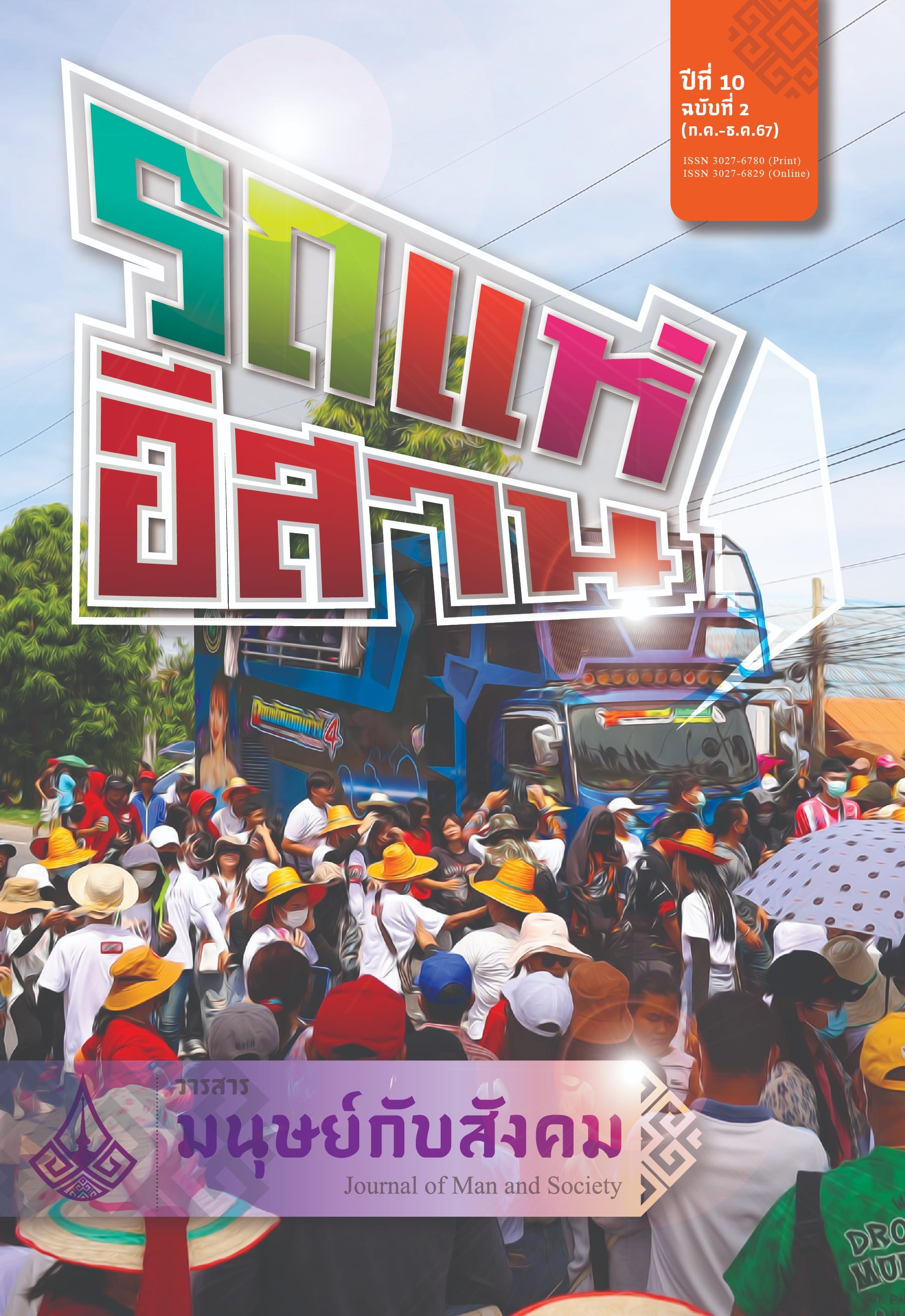Guideline of learning Activities for 21st Century Citizenship: A Case Study of Sirindhorn Museum
Main Article Content
Abstract
The rapid economic, social, and technological changes in the 21st century, both positive and negative, necessitate that citizens develop diverse and complex skills, such as awareness, critical thinking, creativity, effective communication, and collaboration, to tackle challenges and seize opportunities in the digital age. Sirindhorn Museum, as an informal learning center, plays a key role in promoting scientific knowledge through various activities such as exhibitions, lectures, and learning programs. Its primary goal is to foster awareness of the world’s changes by understanding the past, which, in turn, connects to the present and future. Statistical data indicate that over 300,000 visitors, including students, undergraduates, and generals, visit the museum annually. Among them, upper primary school students (ages 9 – 12) represent the largest group of visitors. This age group is conducive to skill and potential development across multiple dimensions. This study aims to explore methods for organizing learning activities and examine the attitudes formed after participating in learning activities at the Sirindhorn Museum, particularly for fostering 21st century skills. This study uses an action research method. The samples were 27 specific populations relevant to learning activities at the Sirindhorn Museum, selected through purposive sampling using the developed learning activities as research tools, including behavioral observations, in-depth interviews and an evaluation form using emoji symbols to represent emotions. The study found that children aged 9 – 12 are naturally inclined towards challenges, hands-on experiences, and social acceptance. Consequently, learning activities should emphasize engagement through hands-on tasks, self-guided discovery, and multiple pathways for exploration based on personal interests. Museum staff should act as facilitators, encouraging discussions and introducing environmental themes. Offering diverse, free learning activities also positively influences parents and teachers to bring their children or students to the museum. The assessment of participants’ attitudes following the activity indicated a significant improvement in their global consciousness. This finding highlights the role of the activity design in enhancing critical 21st century citizenship skills, emphasizing the need for regular implementation of such initiatives.
Article Details

This work is licensed under a Creative Commons Attribution-NonCommercial-NoDerivatives 4.0 International License.
เนื้อหาและข้อมูลที่ตีพิมพ์ลงในวารสารมนุษย์กับสังคม ถือเป็นข้อคิดเห็นและความรับผิดชอบโดยตรงของผู้เขียนซึ่งกองบรรณาธิการวารสารไม่จำเป็นต้องเห็นด้วยหรือร่วมรับผิดชอบใดๆ
บทความ ข้อมูล เนื้อหา รูปภาพ ฯลฯ ที่ได้รับการตีพิมพ์ในวารสารมนุษย์กับสังคม ถือเป็นลิขสิทธิ์ของวารสาร หากบุคคลหรือหน่วยงานใดต้องการนำทั้งหมดหรือส่วนหนึ่งส่วนใดไปเผยแพร่ต่อต้องอ้างอิงวาสาร
References
กฤษฎา เศรษฐกุดั่น. (2562). พิพิธภัณฑ์ในฐานะแหล่งการเรียนรู้ของประชาชน กรณีศึกษาการเปิดรับสื่อ การรับรู้ และทัศนคติของกลุ่มมิลเลนเนียลที่มีต่อพิพิธภัณฑ์ธนาคารแห่งประเทศไทย [วิทยานิพนธ์ปริญญามหาบัณฑิต, มหาวิทยาลัยธรรมศาสตร์]. TU Digital Collections. https://digital.library.tu.ac.th/tu_dc/frontend/Info/item/dc:177780
กฤษณพงศ์ เลิศบำรุงชัย. (2562, 21 กุมภาพันธ์). พีระมิดแห่งการเรียนรู้. Touch Point. https://touchpoint. in.th/cone-of-learning/
ญานิศา อยู่งาน. (2558). รายงานการวิจัยเรื่อง การพัฒนานักเรียนให้มีทักษะในศตวรรษที่21 โดยการวิจัยการปฏิบัติการแบบมีส่วนร่วม กรณีศึกษาโรงเรียนบ้านหนองดอกบัว สังกัดสำนักงานเขตพื้นที่การศึกษาประถมศึกษาเลย เขต 1. สำนักงานคณะกรรมการการวิจัยแห่งชาติ (วช).
ฐิติมา ชูใหม่. (2559). การเจริญเติบโตและพัฒนาการของเด็กปฐมวัย. วารสารหัวหินสุขใจไกลกังวล, 1(2), 18 -33.
ณัฏฐิณี กาญจนาภรณ์ และชนิดา ล้ำทวีไพศาล. (2564). พิพิธภัณฑ์ในบทบาทของพื้นที่ทางสังคม: ความสำคัญของการพัฒนาพื้นที่และสิ่งอำนวยความสะดวกในพิพิธภัณฑ์. มหาวิทยาลัยเทคโนโลยีพระจอมเกล้าธนบุรี.
ณัฐสิฏ รักษ์เกียรติวงศ์, ศุภณัฎฐ์ ศศิวุฒิวัฒน์ และเทียนธันย์ ณีศะนันท์. (2561). ปรับการเรียนรู้เพื่อสร้างทักษะใหม่. สถาบันวิจัยเพื่อการพัฒนาประเทศไทย (ทีดีอาร์ไอ).
ธนพร เลิศโพธาวัฒนา. (2561). การพัฒนาความสามารถในการคิดวิเคราะห์และผลสัมฤทธิ์: ทางการเรียน วิชาชีววิทยา เรื่อง ยีนและโครโมโซม โดยใช้รูปแบบการจัดการเรียนรู้สำหรับศตวรรษที่ 21: MACRO MODELของนักเรียนชั้นมัธยมศึกษาปีที่ 6 [วิทยานิพนธ์ปริญญามหาบัณฑิต, มหาวิทยาลัยรังสิต]. RSUIR at Rangsit University. https://rsuir-library.rsu.ac.th/handle/123456789/807
ธนาศิริ สุธีธร. (2554). การจัดทำคู่มือการเรียนรู้สำหรับนักเรียนระดับประถมศึกษาตอนปลายประกอบการชมนิทรรศการถาวรภายในพิพิธภัณฑ์สิรินธร [วิทยานิพนธ์ปริญญามหาบัณฑิต, มหาวิทยาลัยมหิดล]. Digital Research Information Center. https://dric.nrct.go.th/index.php?SearchSearchDetail/282255
พรรณฑิรา สุวรรณสถิต. (2560). การจัดการการเรียนรู้ด้านประวัติศาสตร์สำหรับเยาวชน ณ พิพิธภัณฑ์ผ้า ในสมเด็จพระนางเจ้าสิริกิติ์ พระบรมราชินีนาถ [วิทยานิพนธ์ปริญญามหาบัณฑิต, มหาวิทยาลัยธรรมศาสตร์]. TU Digital Collections. https://digital.library.tu.ac.th/tu_dc/frontend/ Info/item/dc:91135
พาสนา จุลรัตน์. (2548). จิตวิทยาการศึกษา. มหาวิทยาลัยศรีนครินทรวิโรฒ.
พิพิธภัณฑ์สิรินธร. (2567). สถิติผู้เข้าชมพิพิธภัณฑ์สิรินธร. พิพิธภัณฑ์สิรินธร จ.กาฬสินธุ์. http://www.sdm.dmr.go.th
ราชวิทยาลัยกุมารแพทย์แห่งประเทศไทย สมาคมกุมารแพทย์แห่งประเทศไทย. (2560). คู่มือสำหรับพ่อแม่ เพื่อเผยแพร่ความรู้ด้านการดูแลและพัฒนาเด็ก ตอนเด็กวัยเรียน 6-12 ปี. Thai Pediatrics. https://www.thaipediatrics.org/?p=891
วิจารณ์ พานิช. (2556). สอนอย่างไรในศตวรรษที่ 21. Youtube. https://www.youtube.com/watch?v=J2 zpoCcqayc
สำนักงานราชบัณฑิตยสภา. (2557, 27 สิงหาคม). ทักษะแห่งศตวรรษที่ 21. สำนักงานราชบัณฑิตยสภา. http://legacy.orst.go.th/?knowledges=ทักษะแห่งศตวรรษที่-๒๑
สำนักงานคณะกรรมการการศึกษาขั้นพื้นฐาน. (2558). การจัดการเรียนรู้เชิงรุก (Active Learning). สำนักงานคณะกรรมการการศึกษาขั้นพื้นฐาน.
สุทธิวรรณ ตันติรจนาวงศ์. (2560). ทิศทางการจัดการศึกษาในศตวรรษที่ 21. Veridian E-Journal, Silpakorn University ฉบับภาษาไทย มนุษยศาสตร์ สังคมศาสตร์ และศิลปะ, 10(2), 2843-2854.
สุมาลี สังข์ศรี. (2548). รายงานการวิจัยการจัดการเรียนรู้ของแหล่งการเรียนรู้ตลอดชีวิต: พิพิธภัณฑ์. สำนักงานเลขาธิการสภาการศึกษา กระทรวงศึกษาธิการ.
Battelle for Kids. (2019). Framework for 21st Century Learning. battelleforkids. https://www.battelleforkids.org/wp-content/uploads/2023/11/P21_Framework_Brief.pdf
Hahn, C. L. (2017). The role of education in global citizenship. Journal of International Education in Business, 10(1), 1-14.
Oxfam. (2015). Education for global citizenship: A guide for schools. Oxfam International.
UNESCO. (2014). Global citizenship education: Preparing learners for the challenges of the 21st century. United Nations Educational, Scientific and Cultural Organization.


